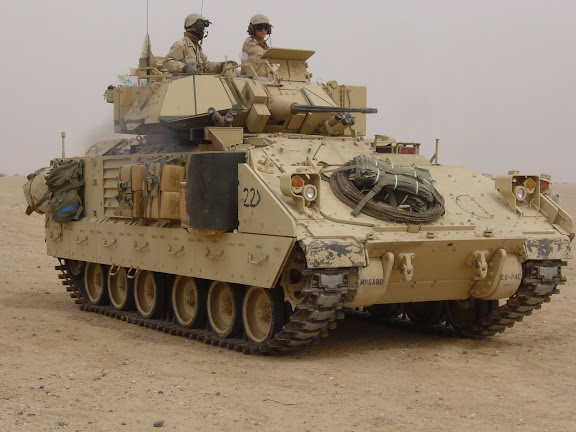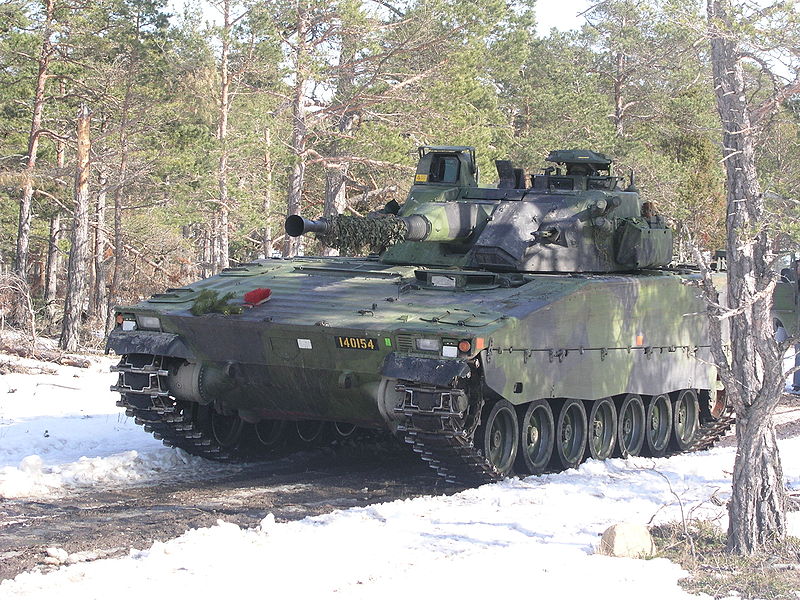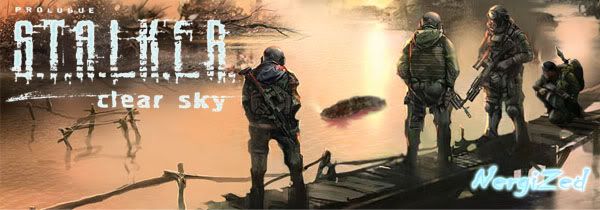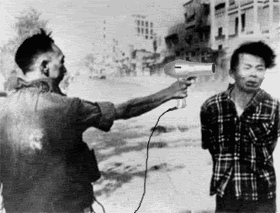M2A3 Bradley Infantry Fighting Vehicle - United States of America

Armament: 1x Bushmaster II 30mm autocannon, 1x 7.62mm coaxial machine gun, 1x twin launcher for TOW/Javelin missiles, 2x firing ports for M123 Firing Port Weapons (adapted M16 assault rifles)
Seating: 3 crew, 6 infantry
Probably the most well-known modern IFV, the Bradley sits comfortably in the middle range of firepower, mobility and armour. It has considerable battle experience, with somewhat mixed results in urban environments, mostly highlighting the need for greater RPG protection in city streets and leading to most modern models being equipped with reactive armour kits; it has fared much better in open battle, scoring more armoured vehicle kills than the M1 Abrams tanks, though it also proved unable to withstand being hit nearly as well. It in fact did well enough that the U.S. Army have developed the M3A3 Bradley Calvalry Fighting Vehicle better-optimised for tank hunting, with fewer infantry and no firing ports but better command and control systems for more effective combat operations. It is not amphibious but can reach a respectable top speed of 66km/h.
M1126 Stryker Infantry Carrier Vehicle - United States of America

Armament: 1x Konigsberg PROTECTOR Remote Weapons Station; can fit .50 calibre machine gun or 40mm grenade launcher (or smoke grenade launchers), 1x externally crewed M2 .50 calibre heavy machine gun, 1x externally crewed 7.62mm machine gun
Seating: 2 crew, 9 soldiers
The M1126 is somewhat of a gamble for the U.S. Army as it can't really be considered an IFV, being more of an 'infantry mobility vehicle' given its limited combat capabilities. With a suite of machine guns it can effectively combat dismounted infantry and is well-optimised for urban warfare, but little else; instead, it uses its speed as a wheeled vehicle, up to 100km/h, and unmatched networking capabilities to coordinate movements in groups and effectively avoid threats. It can also carry a better load of inantry than most other IFVs. Armour plating is minimal compared to a dedicated IFV, but will still protect the vehicle and its occupants from machine gun fire and shell splinters, and anti-RPG racks such as those seen in the image above provide some protection against anti-tank weapons.
BMP-3M Infantry Fighting Vehicle - Russian Federation

Armament: 100mm cannon; also fires 9M117M1 Arkan ATGMs, max. range 5.5km, coaxial 30mm autocannon, 1x coaxial 7.62mm PKT machine gun, 2x internally-crewed 7.62mm PKT machine guns (bow-mounted, 1 per side)
Seating: 3 crew, 7 passengers
The latest iteration of the line which started the IFV concept, the BMP-3M is a wholesale upgrade to the armament systems of the original BMP-3. With extended ammunition sets and autoloader, the more capable Arkan ATGMs over the original Bastion model and new gunner's and commander's sights, including thermal imaging systems, the 3M upgrade increases lethality over three times in some cases over the base model (at least if you believe the manufacturer's brochures, anyway). The BMP-3M is also fully compatible with the Arena Active Protection System; shown in the image above, this comprises a millimetre-wave radar and a series of silos arrayed around the turret; this will detect incoming fast-moving projectiles such as ATGMs and launch small explosive fragmentation charges to destroy them. Its predecessor, Drozd, deployed in Afghanistan in the 1970's proved to work well against Taliban RPGs, scoring 70% or better defeat ratios against missiles approaching from the forward arc (the only arc this system could actually cover; the Arena gives all-round protection). Arena is fitted on BMP-3K command vehicles and some BMP-3Ms at a regimental or better level. Also the BMP-3M boasts by far the heaviest firepower loadout here; its 100mm gun is tailored for annihilating any vehicular foe save an MBT, which it accomplishes with its Arkan ATGMs, which can be fired on the move against targets on the move and range out to 5.5km, providing a unique system among IFVs (and are supposed to disable an MBT in two shots, but again that's from the brochure and is somewhat up for debate). The coaxial 30mm chaingun can be used against other IFV-type vehicles or aerial threats, and two remote-operated machine guns in the bow round out the arsenal with additional anti-infantry firepower. It can also carries an equal or greater number of passengers when compared to other similar IFVs and is fully amphibious, and at 72km/h its top speed is higher than all its contemporaries save the British Warrior. Armour consists primarily of welded steel giving protection against machine gun fire, but not too much else; however in addition to Arena BMP-3Ms can be fitted with ERA kits, though this doesn't happen too often. Stock BMP-3s also beat both the Bradley and the Warrior in competitive mobility, weapon accuracy, firepower and cruise performance tests by the United Arab Emirates in 1991.
BMD-4 Airborne Infantry Fighting Vehicle - Russian Federation

Armament: 100mm cannon; fires 9M113 Konkurs ATGMs, max. range 4km, 30mm coaxial autocannon, coaxial PKT machine gun
Seating: 3 crew, 4 passengers
Developed specifically for the VDV, Russia's airborne forces, the BMD-4 packages the firepower of the BMP-3 into a much smaller, lighter package to enable it to be air-droppable. The BMD-4 is designed to be delivered out of an Il-76M transport aircraft, and in theory (though I don't believe it's ever been done in practice) can be dropped with crew and troops inside, giving it a huge mobility advantage when compared to all other vehicles here, but the tradeoff is a very small troop complement and weak armor. Still, its heavy weapons layout and fully amphibious capabilities enable it to provide extremely effective fire support and mobility to infantry for a rapid-attack strike force inserted into enemy territory, the primary needs of the VDV.
Puma Infantry Fighting Vehicle - Germany

Armament: 30mm autocannon, coaxial 5.56mm MG4 light machine gun, EuroSpike Spike-LR ATGMs (max. range 4km) (n.b. unsure as to configuration of Spike launcher; probably two ready to fire, possibly 1, not currently fitted but will be upgraded) (Also note that all above armaments are located in remotely-operated main turret), 76mm remote-operated 6-shot grenade launcher covering rear exit door
Seating: 3 crew, 6 passengers
The most modern IFV on this list, the Puma is a brand-new creation by Rheinmetall Landsysteme and Krauss-Maffei Wegman, packaging the cutting edge of current fighting vehicle technology into a highly traditional design. The 30mm cannon, coaxial MG and missile launchers are located in a fully remote turret, simplifying the crew layout, and the Puma also has a revolutionary kit-based armour design; the armour is modular and can be attached in two levels of protection, A, and C (B was scrapped when it was found C did everything it could and more), with C being the highest. The armour is composite and considerably more durable than most IFV protection, providing immunity to all heavy MG fire across all sides and better on the front (class C kits upgrade all sides to the same protection as the front, that is, all sides are able to resist direct 30mm AP round hits). It is also said to defeat simple hollow charge warheads. Pumas are designed to be transportable by A-400M cargo aircraft, though the armour kits must be carried separately, and can be fitted with ERA or other armour kits in future if the need arises. They are equipped with multiple remote cameras and other sensors, giving them excellent sensor and networking capabilities. Pumas also possess the highest power to weight ratio of any IFV in service today, reflected in their 70km/h top speed and considerable torque.
Combat Vehicle (CV)9040M Infantry Fighting Vehicle - Sweden

Armament: 40mm Bofors autocannon, 7.62mm coaxial machine gun
Seating: 3 crew, 7 passengers
The CV9040 is a wide-ranging family of vehicles produced by Hagglunds of Sweden; they utilise the powerful Bofors 40mm cannon, which is a larger calibre than all of the other autocannons used here (though obviously it is outstripped by the 100mm guns used on the Russian BMP-3M and BMD-4, these can only fire once every few seconds using a traditional loading process; the Bofors gun is entirely automatic). This delivers a range of ammunition types at considerable distance, and is optimised for 'softer' targets such as light armoured vehicles or aircraft (the CV9040 has a dedicated air defence variant with merely a radar added, so its tracking capabilities are entirely good enough for this purpose). The CV9040M gains the benefit of a fully-stabilised gun system, allowing excellent accuracy, though the gun can no longer be elevated to quite the degree of the base CV9040. However, the CV9040 doesn't mount ATGMs, so the 40mm gun is besides the mandatory coaxial MG effectively its only armament. With 7 passengers the CV9040 is a capable transport, and while it is strictly non amphibious it can attain a very good top speed of 70km/h.
FV510 Warrior Infantry Fighting Vehicle - United Kingdom

Armament: 30mm RARDEN autocannon, 7.62mm coaxial chain gun, 7.62mm externally crewed machine gun
Seating: 3 crew, 7 passengers
The FV510 is an older but battle-tested IFV design that is operated by the UK as the Army's primary IFV. Its 30mm RARDEN cannon is equivalent to most IFV weaponry, and the 7.62mm chaingun is an unsual put powerful weapon designed from the outset to be coaxially-mounted, thus providing exceptional anti-infantry firepower. The Warrior also has something of a reputation for durability, having successfully faced mines, RPGs, small arms and missiles in Bosnia, and can also be fitted with cage anti-RPG armour or ERA kits for additional protection. The FV510 is not amphibious, but faster than all of its tracked contemporaries at 75 km/h.
LAV III Piranha Infantry Carrier Vehicle - Canada

Armament: 25mm chaingun, 7.62mm coaxial machine gun, 7.62mm externally crewed machine gun
Seating: 3 crew, 7 passengers
One of the most modifiable light armoured vehicles out there, the LAV III series is highly mobile like the Stryker but with a much heavier weapons layout. The 25mm Bushmaster chaingun is an efficient and proven weapon, and combined with the 2 MGs provides the capcity to deal with the majority of light vehicle and infantry threats. As a wheeled vehicle the LAV III can travel up to 100km/h, and also has amphibious capability, though I believe it must be readied first for three or so minutes. Armour on the LAV III is decent, providing protection from most MG rounds and shrapnel, but can't stand up to heavier weaponry; this can be remedied to a small extent by anti-RPG cages, though unfortunately they can increase the LAV III's unfortunate tendency to roll, produced by its high centre of gravity, and thus also a high silhouette.
Fire away - I'll detail more later, but for now I have to go, so get voting folks!
Edited by CommanderJB, 09 August 2008 - 03:11.
















